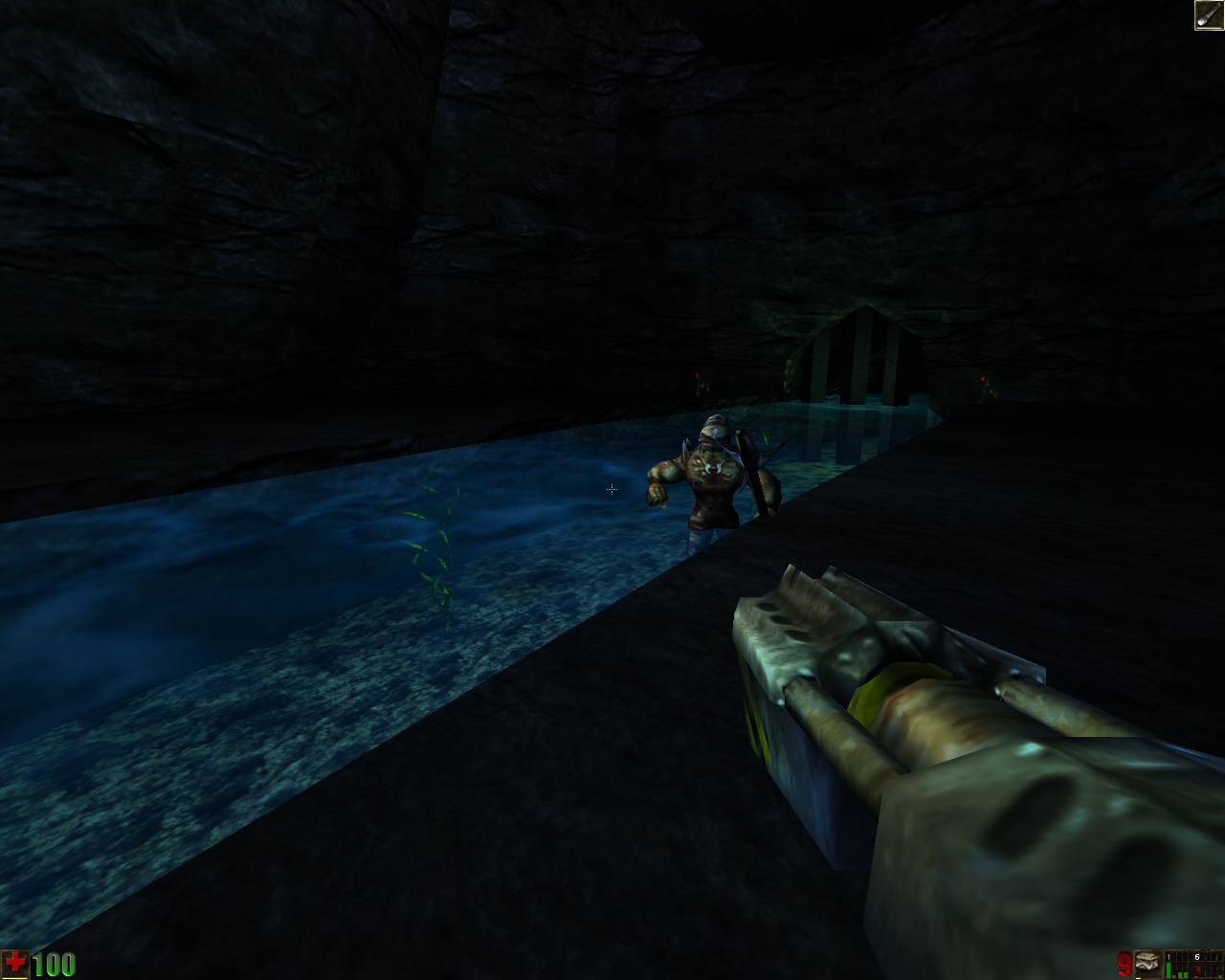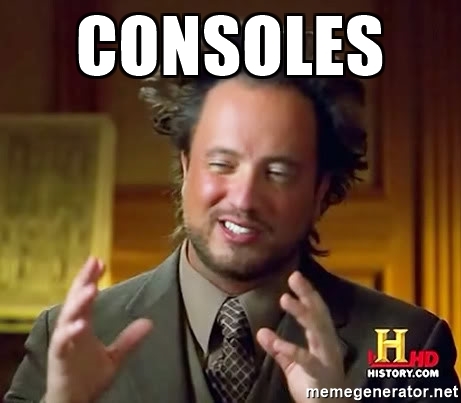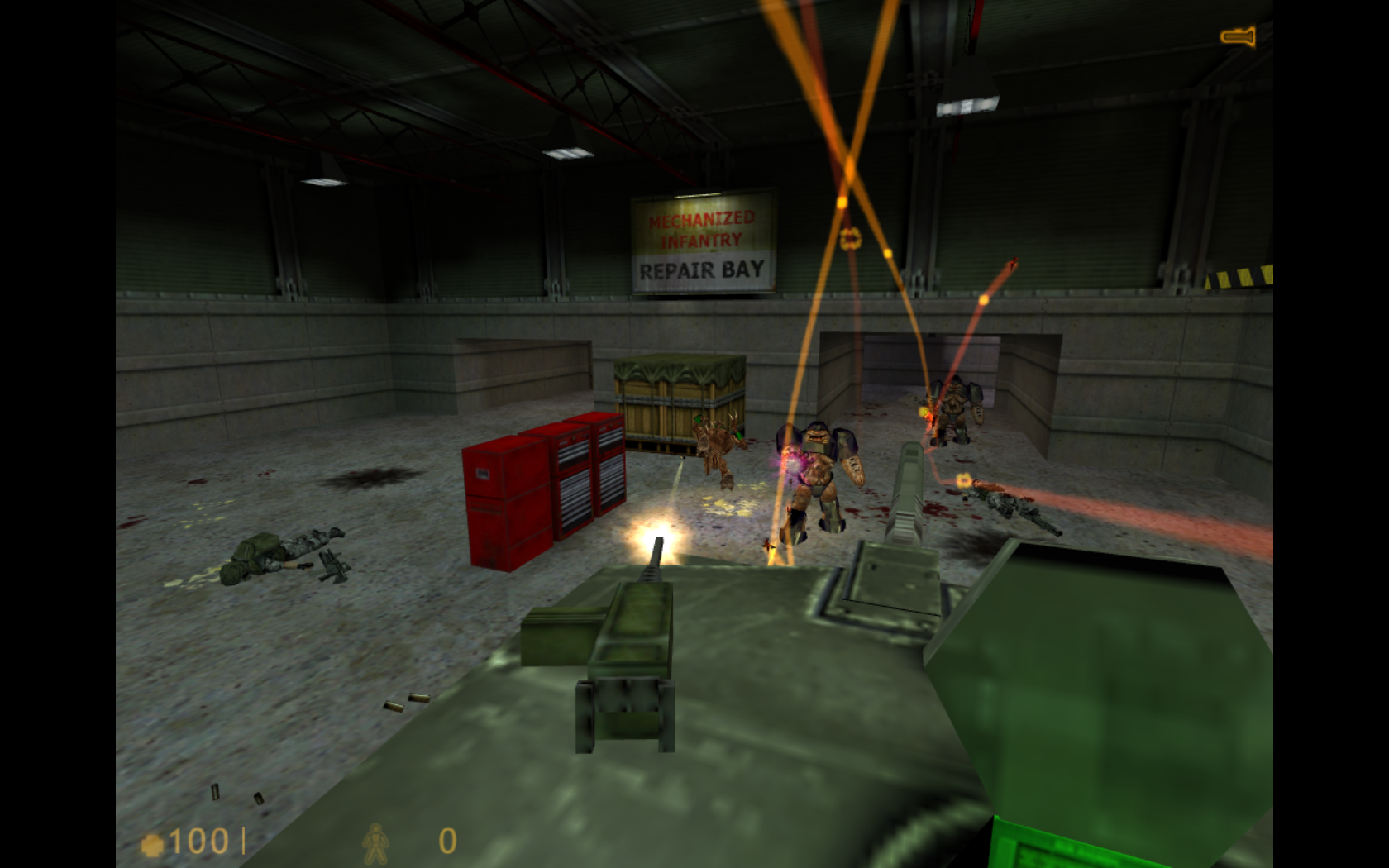As always, I am generally writing to and from the position of FPSes.
There are three axes for skill settings, broadly speaking, which can change (non-exclusively) to adjust the difficulty, they are:
- Behavioral – Enemies gain or lose abilities, display different reaction times, change tactics, and vary in accuracy and prediction. A simple illustration of this is in the original Unreal where the combat capability of the monsters was modified by the difficulty level you selected.
- Nightmare difficulty deserves a special note here, as it often increases monster attack speed, general aggressiveness, and may include elements such as respawning. Nightmare was created for Doom in a patch, a response to player complaints that Ultra-Violence was too easy. You may want to read my small article on Duke Nukem 3d’s higher difficulties.
- Economical – Health, armor, and ammo are more scarce, inventory may be limited. This can engender an anti-completionist attitude, or drive the secret hunter all the further.
- Circumstantial – This one is a bit broader and can include changing level layouts, though less common due to technical and labor reasons, but more often involves Economical changes on top of enemy positioning, quantity, and composition changes. This method was commonly used in FPSes and can be seen extensively in Quake for the wide shifts in level density and battle complexity depending on the difficulty.
These increase the cognitive load on the player, asking him to factor in more at a time for decision making, thus asking the player to use their existing education about the game in a more strenuous form, while mentally juggling changing data points, which takes us back to the simple notion that learning is fun, when focused and applied.
(Allow me a brief moment to acknowledge that all changes are implicitly a factor in cognitive load, but that does not make the cognitive load the primary axis of difficulty.)
A great example of the Circumstantial difficulty axis can be seen in e1m3 of Quake, the Necropolis. I did a quick run of the first two fights on Easy, then Normal, and then Hard to show case the differences, give it a look:
Those are pretty drastic experiences. Easy difficulty tells you what to do in the crusher trap at the beginning and puts the enemies in front of you. Normal removes instruction, and offers some enemies to the flank, as well as extending the fight. Hard upends the table, hitting the player with a pincer attack by two Fiends, very dangerous enemies in and of themselves, puts a zombie ambush in the connecting hallway, expands the flanking locations of the Scrags even more, replaces the Ogre with a Shambler (arguably the toughest enemy in the game), and even puts in a trigger when you enter an exposed area to spawn another Shambler, putting the player at a distinct disadvantage. These are rather different experiences and give a different feel to the world, as well as the player’s relationship to the world, and that was with a Fiend getting caught on the stairs, and the Shambler wandering into a bad spot for himself.
What each of these axes of difficulty plays upon is the cognitive load of the player. How much are we asking him to process at any given moment? How much are we asking him to keep track of? The more you tweak each of these axes, the more you increase cognitive load, the Quake footage for example is almost strictly Circumstantial, and that alone shows a marked increase in expectations on the player, but it also gives the player more game to play as they get better. By the end of an episode of Quake on easy, you may be ready for it on Normal. It grows the player.
However, we don’t see this as often. Rather than changing the game world, and what the player has to work with, we now more commonly see simple mathematical adjustments such as how much damage they take from an enemy attack. Be it Skyrim, Doom 4, Call of Duty, or many others, it isn’t what you are dealing with, but rather the recovery from mistakes. The game has shifted from serving you more involved elements to punishing you harder for errors, and in a time where manual saves are exceptionally rare.
These combined aspects discourage learning from mistakes and experimentation, because the true punishment isn’t in your health, but on your time, as you replay a segment you have demonstrated mastery of in order to reach the encounter you have not yet mastered. Unless you have an excess of time, this encourages playing more conservatively. Rather than grow your skills, you play it safe, you retreat, and you continue a cycle of later encounters going the same way.
So why are we getting games with difficulty like that now? Well, on the surface level, it is easier. It is easier to run damage calls through a multiplier based upon the difficulty value than it is to create new behaviors, balance combat AI in a wide variety of scenarios, arrange resources differently, or compose new arrangements and combinations. The cost of labor is substantial in game development, and anything labor intensive that isn’t absolutely necessary is quick to get cut.
But beyond that, FPSes and similar are now a multi-platform product, targeting PC and console alike, and though consoles are much more powerful, they are as always a fixed hardware target, and being a fixed hardware target, it is important to calculate your performance budget. With a budget in place, you want as few variables as possible to control for player behavior, and thus you don’t want a significantly different number of meshes on the screen, or going over a certain count of entities doing pathing calculations (especially around each other) every tic, or even every few tics. Now I’m not laying the blame on certain platforms for the simplification of difficulty in video games, such that our relationship is changing in some ways.
All jokes aside, that isn’t the case, though the culprit still resides in a carefully developed environment which can not withstand substantial variation, and that is the scripted linear game world. Half-Life is the earliest FPS I am aware of which does not do Circumstantial or Behavioral difficulty, and only mildly touches on Economical (the medkit value is impacted). However, this was not a time saving technique as all of the monster health and damage values were manually tweaked, as evidenced by the range of variance. Half-Life wanted each area and battle to play out generally the same, save some inter-group fighting. As in most cases, Half-Life was imitated, and not long after we had the rise of the console FPS which reinforced the trends, on top of riding the new wave of more and more imitating film in as many forms. We solidified difficulty toward punishment over cognitive load, which worked fine for delivering a story, but also made the gameplay more of a commodity.
Now we are largely in a position where Difficulty impacts only health and damage numbers, where you don’t get a more interesting experience, but simply a more punitive one. How do we return to the form of cognitive load emphatic difficulty settings? Well, that is a significant challenge, as punitive difficulty design coalesces much better with story, set piece, and scripted event oriented gameplay, and plays nicely for console development. I suspect that in order for the trend to revert, we will need a return to mechanic and systems oriented games, anchored to a theme, rather than in service of a linear story, or for the purpose of delivering set pieces.





As such observations about difficulty usually do, this article has me thinking about the way a lot of procedural and entirely non-linear games manage difficulty. I’m personally quite fond of games that parcel out the difficulty geographically. For me at least it changes my play style to balancing time spent getting stronger against my own boredom. If I start getting tired of goofing around in the sandbox I go do the next story mission, or if it’s entirely sandbox I give tackling that harder area another try.
Those sorts of difficulty designs don’t lend themselves well to old school difficulty settings like Quake’s, but they often allow a game to be designed with a single difficulty, which can save on those labor costs.
In the case of Quake and other player-skill testing games it’s a lot more important to provide breadth of difficulty to allow the player to explore the depth of the systems, mechanics, and their own skill. I’ve never been a hugely skilled FPS player, but I have experienced “flow” a few times, and that always comes after I’ve spent time exploring that depth.
I’m actually glad that a lot of games (indies at least) are skipping difficulty selection entirely. It’s not right for every genre, and screwing it up in one genre causes players to think about it the wrong way in genres where difficulty selection is really important. Some players skip straight to the highest difficulty and judge a game based on what is often a pure punishment experience. Then the other end of the spectrum is players who always choose the lowest difficulty because they don’t think they’ll want any challenge. And both types of player are often wrong in games that actually change mechanics or enemy abilities with difficulty level.
I think I’ve kinda rambled without reaching any specific point, so I guess this is just me dumping some hopefully relevant thoughts.
I very much appreciate that in Fallout: New Vegas, much of the gating is done by Deathclaws, Cazadores, and literal guard posts. Sure the game has difficulty settings, but I loved that the world difficulty wasn’t uniform.
My brother keeps telling me I need to play New Vegas. I just haven’t felt like putting the effort into getting the minimal set of mods setup. Every Bethesda game takes me like 8 computing hours to get running before I even start anything but test characters.
One of the things Oblivion and Skyrim did poorly was that geographical difficulty. Particularly in Skyrim there just seems to be effectively random places that are harder than others. Getting to the entrance of a dungeon doesn’t tell you whether you’ll be up to snuff for what’s in it. Oblivion just overdid adjusting everything based on player level.
I’ve been following more or less exactly the same philosophy.
It’s really tempting when editing QC to turn every number you can find into a variable over ‘skill,’ because it’s just so easy to do. Faster projectiles, tighter homing on voreballs; instant difficulty settings! If lots of such things in the mechanics are subtly or invisibly stacked against the player in ways he can’t easily recognize and relearn when switching difficulty levels, instincts developed on Normal don’t help if trying the mod on Hard or Nightmare. If instead a map has more monsters and less health, the player understands the harder situation he’s in intrinsically, and existing hard-learned instincts are what will see him through.
Doom is full of little ways that weapon fire rates, monster pain chances, and attack_finished times are tuned to each other that are critical to risk/reward microdecisions, and building instincts around their consistency is what leads to a feeling of mastery. If that tuning went out the window with each new difficulty level, Doom would simply be four different and worse games.
I actually went through and removed a number of skill-based mechanical changes from the progs for lunsp2, including the terrible Nightmare turret-mode AI. Instead I just made the player’s max health 50 on Nightmare and left everything else the same as Hard. Numerically, this is exactly the same as doubling monster damage, but reduced max health is immediately understood by the player because it’s visible on the HUD, and instantly teaches him to play differently (in constant, tense ‘one health hype’ mode), while a damage multiplier leads to “just dying way more often for some reason” because the player’s instincts from skills 0/1/2 all suddenly ‘feel’ wrong when playing on skill 3. “I thought I could survive a fiend pounce with 60 health, what gives?”
I will argue that faster projectiles makes for an easier game, as it makes taking cover, or simple sidestepping, a much more consistent solution, and it reduces the volumetric data you need to keep in mind for your movement. Doom 4 imps can supercharge blast you to pieces, but Doom imps can fill a large space with fireballs resulting in a painful and moving obstacle course, which makes you lose track of something nastier.
You make an excellent point on the player understanding why things are going the way they are, which is critical for player growth. This reason alone is why I am hesitant about the Behavioral axis for difficulty, even if it does operate on cognitive load, as it is less clear how to grow. You’re doing well on Easy, so you bump to Normal, and get slaughtered. The enemies seem more accurate – but as a player you aren’t skilled enough to realize that on Normal, they lead their shots, so you need to move more erratically. You went from a game you like that was perhaps lacking in challenge, to a game you don’t understand which is annoying, and you don’t have a frame of reference as to why.
A simple reason for me to favor Circumstantial difficulty is, it puts more power in to the hands of the level designer, which is a vocation I wish had more power today in games.
Damage multipliers also task the player with doing additional math in their heads, which tends to feel more like a burden and less like a challenge. Doubling a number isn’t hard, but, that’s not why you’re playing Quake.
Fixed monster capabilities across all difficulty levels seems like the “right” way to do things. The monsters are always exactly as capable. Even leading/not leading seems like an ultimately bad call. Unless you describe the differences in the difficulty levels.
More monsters or tougher types of monsters is what I like to see. To the point where maybe the top 2 or 3 toughest monsters just can’t show up at the lowest difficulty.
And an ugly but effective solution if you do feel the need for more monster HP/Damage is recolors. A visual indicator that this is the same monster behaviorally, but that it hits harder or absorbs more damage, or both.